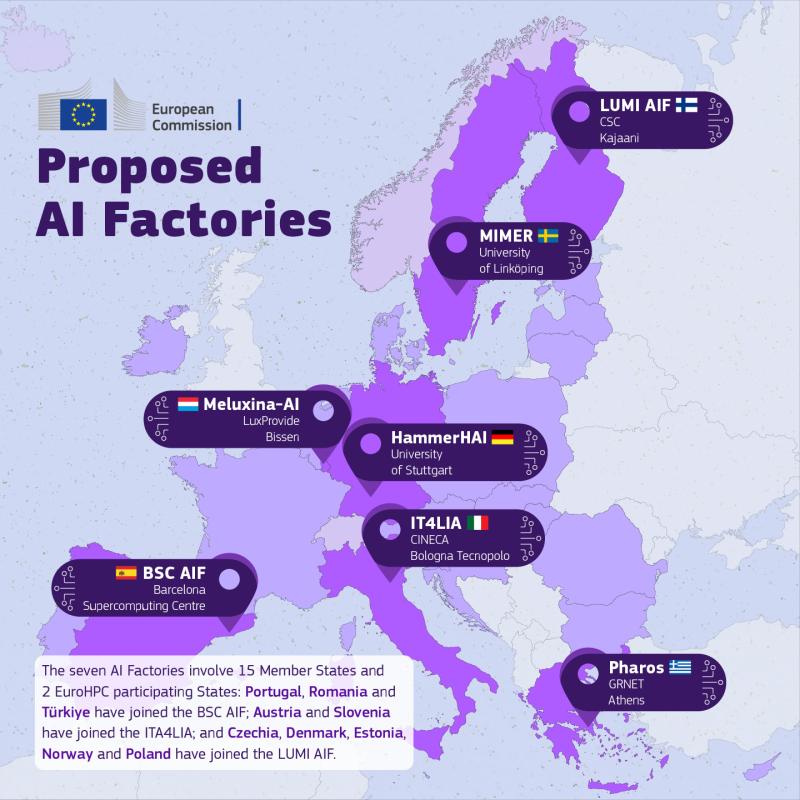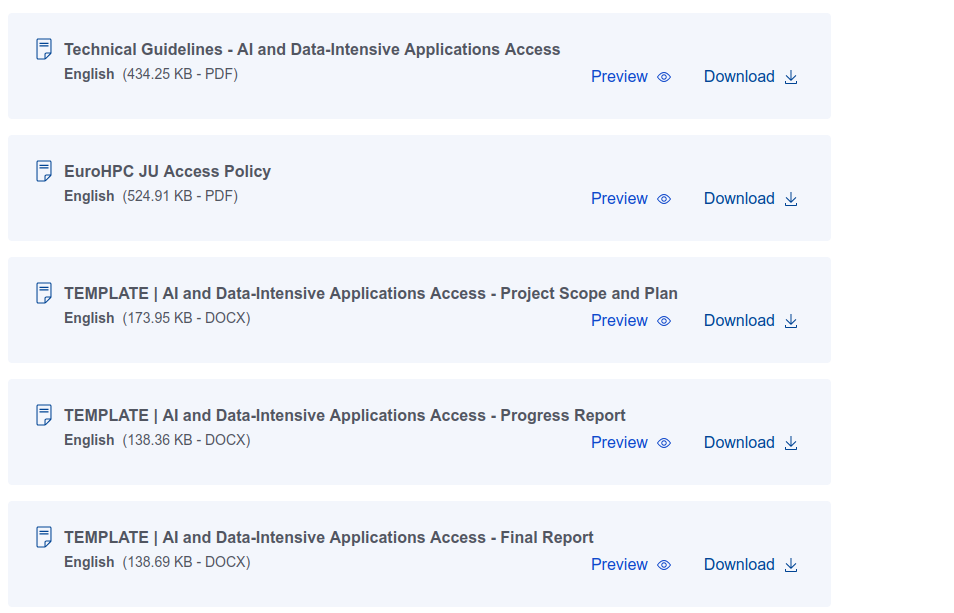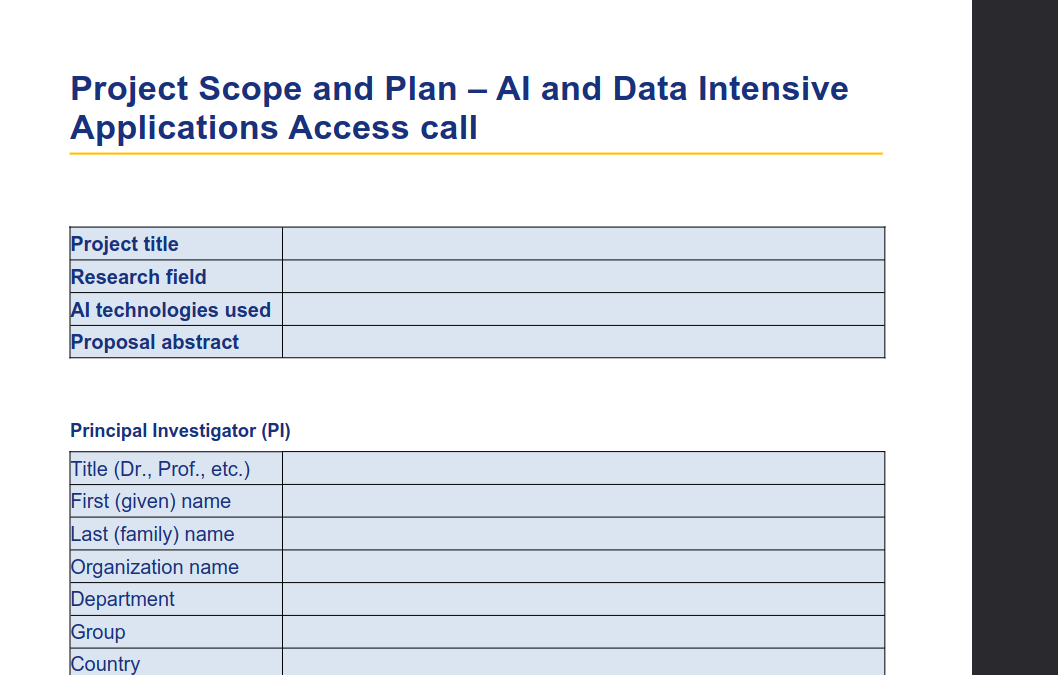As promised in this blog, I continue to review the European plans for AI development announced at the Paris AI Summit. Ursula von der Leyen emphasized Europe’s computing power and declared that AI Factories are the future of European industry as a great example of public-private partnership. Awesome, so what are they?
It started with EuroHPC #
The European High Performance Computing Joint Undertaking (EuroHPC JU) - that is a catchy, easy-to-remember name for a project, isn’t it? It is basically a pan-European infrastructure, a kind of pool of the continent’s computing power (supercomputers) accessible to universities, research and industry. People can apply and, if accepted, use the free resources of the European computing centres. They are mainly used by academics (not only, but mainly) or, in some cases, by government bodies.
Programme extension #
As far as I understand, AI Factories in Europe are seen as an extension of this existing initiative.

Planned locations for AI factories. Source: European Commission.
The EU wants to somehow expand the computional power of these centres and expose them more into the world of startups and industrial and comercial projects. It’s not that EuroHPC doesn’t do business-oriented projects, but the idea is that it can do more, especially for AI (5 new supercomputers optimaize for AI). It’s all part of a larger initiative that aims to “support European startups and SMEs in developing trustworthy artificial intelligence (AI) that respects EU values and rules.”
AI that respects EU values and rules ;-) A lot could be said about this, and even, OH NO!, a few sarcastic words. But let us assume that the authors of this beautiful phrase had in mind the AI Act and the various regulations it brings with it.
So far, so good.
When and how? #
Note here that EuroHPC already has the AI-oriented programmes. And how to apply? How easy is it to get access to resources?
Well, not that easy, but it can be done :) This is something you can generally see in all EuroHCP programmes. I know a couple of people who were part of an academic team that applied and got access (not an AI project, but they had a lot of data). It took them a few months to prepare the application, apply and get accepted. As far as I remember, they had access for 1 year and the queue to start a job was about 36 hours. Woe to you if you did not prepare your job well. The good thing is that they didn’t pay anything for the calculation done! ;) So first of all, I think the natural question is: is it possible to simplify the application process? If this expansion of EuroHPC is about helping the industry grow, supporting start-ups, then the faster you can get the decision the better for companies in a highly competitive environment. It would be a shame if, after pumping so much money into these HPC, no one thought to modernise the application process. Take a look at these forms and reports.


Source: https://eurohpc-ju.europa.eu/eurohpc-ju-access-call-ai-and-data-intensive-applications_en
It really does look like an EU-style over-bureaucratic approach. It seems that even the language is more suited to the academic world of grant writing than to commercial applications. The team leader takes on the role of the PI? :) And of course you have to write reports after and during the project. I really think that if the Commission is targeting the commercial sector, this is not the best approach. Let’s hope that the high level of competition in AI area will force changes.
From what you can read, for example, on the website of THE supercomputer LUMI (Finland), starting a job doesn’t look too complicated. These are typical solutions for this kind of computer. (Of course, optimising your script for your data is usually the biggest challenge). Personally, I have only had experience with running Apptainer containers (Singularity) in computing centres, and the LUMI web pages state that users can also use this option. That is nice. The LUMI documentation includes training for people who want to migrate ML applications to LUMI. I think I will check it out more.
You can also find interesting announcements about the AI Factories project:
The AI Factories in Spain and Finland will also include an experimental platform that will serve as a state-of-the-art infrastructure for developing and testing innovative AI models and applications, as well as fostering collaboration across Europe.
Does this mean we can expect more software tools for users? To make it easier to create jobs, batches, tweak scripts? I imagine it would be great if companies that get access for, say, a year could just plug in their ML pipelines, or at least get some useful tools to maximise the positive outcome from the power of the supercomputers. If you think the EU is launching other big AI-related initiatives like Testing and Experimentation Facilities (TEFs) and Common European Data Spaces, then you might say: why not join them? Why not create something like the AI Factories Cloud (Oh, boy), which allows the use of platform data to train and test models. Let’s wait and see. I think we should expect a more advanced platform. At least I hope so.
Two side notes. Many people claim that European regulations make life difficult for data scientists/ML engineers. And that all the privacy protections are actually too strong and will jeopardise the purpose of building AI factories. So I would like to address this in a separate post, as it is quite a complex issue.
And secondly, I am not sure if everything will be free for accepted users of AI Factory. If I understand correctly, at least some of the data collections may be for sale.
Finally! BUT WHEN? It has been announced that the first 7 data centres will be built this year. This looks ambitious, but I guess there is no choice but to hurry, as it looks like we are not leading the race at this point anyway. Let’s see if they make it.
M